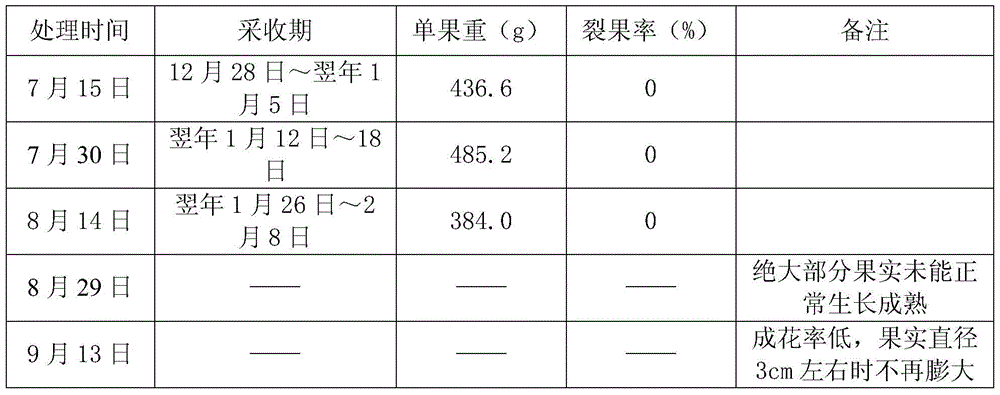Method for producing winter-period fruits of atemoya
A technology for pineapple Sakyamuni fruits and fruiting branches, which is applied in the field of fruit tree production period control and cultivation, can solve the problems of no commodity and edible value, high sugar content of pulp, easy to mold, etc., to achieve value improvement, high fruit setting rate, and simple method easy effect
- Summary
- Abstract
- Description
- Claims
- Application Information
AI Technical Summary
Problems solved by technology
Method used
Image
Examples
Embodiment 1
[0023] In 2013, the test site was set up in the Sakyamuni Demonstration Garden, Dongmen Town, Fusui County, to test the production of pineapple Sakyamuni fruit.
[0024] (1) Cultivation of fruiting mother branches: At the end of March in the spring of 2013, cut off 30 branches above the third-level backbone branches of pineapple Sakyamuni, and apply 20-22kg / plant of decomposed farmyard manure as the base fertilizer; after 8-10 days, a large number of germinations will become fruiting mothers. shoots of branches. When the new shoots grow to 8-10cm, remove the shoots of the clumps and the flower buds of the plants in time.
[0025] (2) Anti-season pruning for flower promotion: Prune once every 15 days from July 15 to September 28. There are 6 treatments in total, 250 branches per treatment, and a single plant block group, repeated twice. In the test process, the germination stage (the time when more than 50% of the shoot buds appear to germinate), the full bloom period (the tim...
Embodiment 2
[0034] Combined with the test results in 2013 to optimize and adjust, in 2014, the test will continue to be carried out in the Sakyamuni Demonstration Garden in Dongmen Town, Fusui County, and the production of pineapple Sakyamuni fruit will be inspected.
[0035] (1) Cultivation of fruiting mother branches: In the early April of 2014, cut off 30 branches above the third-level backbone branches of Pineapple Sakyamuni, and apply 23-25kg / plant of decomposed farmyard manure as the base fertilizer; after 12-15 days, a large number of germinations will become fruiting mothers shoots of branches. When the new shoots grow to 12-15cm, remove the shoots of the clumps and the flower buds of the plants in time.
[0036] (2) Anti-season pruning for flower promotion: Prune once every 15 days from July 1 to September 14. There are 6 treatments in total, 250 branches per treatment, and a single plant block group, repeated twice. In the test process, the germination stage (the time when more...
Embodiment 3
[0045] Combined with the test results in 2013 and 2014, the optimization and adjustment were carried out. In 2015, the test continued in the Sakyamuni Demonstration Garden in Dongmen Town, Fusui County, and the production of pineapple Sakyamuni fruit was investigated.
[0046] (1) Cultivation of fruiting mother branches: In the spring of 2015, cut off 30 branches above the third-level backbone branches of Pineapple Sakyamuni, and apply 20-25kg / plant of decomposed farmyard manure as the base fertilizer; after 10-12 days, a large number of germinations will become fruiting mothers shoots of branches. When the new shoots grow to 10-12cm, remove the shoots of the clumps and the flower buds of the plants in time.
[0047] (2) Anti-season pruning for flower promotion: Prune once every 15 days from June 16 to August 30. There are 6 treatments in total, 250 branches per treatment, and a single plant block group, repeated twice. In the test process, the germination stage (the time whe...
PUM
 Login to View More
Login to View More Abstract
Description
Claims
Application Information
 Login to View More
Login to View More - R&D
- Intellectual Property
- Life Sciences
- Materials
- Tech Scout
- Unparalleled Data Quality
- Higher Quality Content
- 60% Fewer Hallucinations
Browse by: Latest US Patents, China's latest patents, Technical Efficacy Thesaurus, Application Domain, Technology Topic, Popular Technical Reports.
© 2025 PatSnap. All rights reserved.Legal|Privacy policy|Modern Slavery Act Transparency Statement|Sitemap|About US| Contact US: help@patsnap.com



